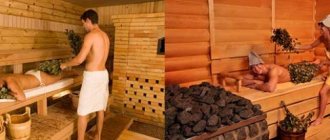Photo: Andrey Shchekalev, shutterstock (09/1/2019) Today, saunas, hammams and other types of similar establishments are being built to replace archaic steam rooms. But no matter how many such varieties are invented, the Russian bathhouse will never lose its popularity and demand among hot lovers. Russian bathhouse is a brand.
What is a Russian bathhouse
A unique symbiosis of several elements at once: air, earth, fire and water. In addition to the fact that this is a place for taking hygiene procedures, it provides an opportunity to relax the body and spirit, and carry out a whole range of wellness procedures.
If you believe history, then the bathhouse has always existed in Rus'. According to legends, it was a log building with a fireplace, and the guardian of the bathhouse and its soul was a naked old man - a bannik.
Chronicles of the X–XIII centuries. they talk about how common baths were among the Eastern Slavs in the 5th–6th centuries, how affectionately they called them mylnya or movnitsa. With the Baptism of Rus', the bathhouse strengthened its influence, as it became a place for mandatory visiting before performing important church rituals.
Russian bath traditions and customs
In Rus', it was traditional to heat bathhouses on Saturdays; for this reason, Saturday was called bathhouse day. In home baths, the whole family took a steam bath: women took a steam bath together with men, and this was not considered something reprehensible. The main difference between public baths was that men occupied one half of the room, and women the other. The division of baths into women's and men's began in 1743, it was then that by a special decree, men over 7 years old were prohibited from entering the women's bathhouse, and women from the men's bathhouse.
(The bathhouse is heated in black)
In Russian culture, the bathhouse is of great importance; over the centuries it has been closely associated with many other traditions and customs. For example, it was customary to visit the bathhouse on the eve of the wedding, as well as the day after the wedding.
The Russian bath played an important role in folk medicine; it was considered a reliable, and often the only remedy against many illnesses and ailments. In this regard, there was a well-known saying in Rus': “If you wash yourself, it’s as if you were born again!” In ancient times, it was even believed that if a steam room did not help a patient, then other healing methods were unlikely to help him.
Rules for taking a bath and preparing for it
For the bath to be beneficial, it is enough to follow a few basic rules:
- Do not drink alcohol both while in the steam room and before visiting it;
- Don’t overeat (you shouldn’t go hungry either, you can get by with a light snack);
- Monitor your condition and do not force yourself to sit in the steam room;
- You can enter the steam room several times, each entry will differ from the other in thermal conditions and duration;
- You should stay in the bathhouse for no more than 25 minutes.
Before visiting you must:
- Douse yourself with warm water or take a shower to prepare your body for higher temperatures.
- To preserve the lipid layer of the skin, which performs a barrier function, you need to refrain from using soap with a washcloth.
- Do not get your hair wet, this will protect you from heat stroke. It is better to put on a hat made of wool or linen, after wetting it.
Sauna – a modern version of the Russian steam room?
Unfortunately, in the second half of the 20th century, the words Russian bath and Finnish sauna began to be perceived by many as synonymous words. The thing is that in the 60s of the last century, a commercial bathhouse project was created in Finland, which was compact and electric.
The ease of installation and small dimensions of the electric oven have made it mega-popular. By the way, such saunas could be installed not only in private houses, but also in apartments.
Such dry-air saunas began to be installed by hotel owners and... go for export! Although the Finns themselves consider electric saunas a product for poor people. And of course, they have nothing in common with the Russian bathhouse. And the whole point is this.
Initially, they did not yet know how to insulate electric heating elements, so pouring water on them could result in a fairly noticeable electric shock. But since manufacturers of electric sauna stoves had to look for new markets for their products, a legend was invented about the life-giving power of dry steam, which cannot even be called steam.
That is why pouring water on stones in newfangled saunas of the second half of the last century was strictly prohibited. And if there is no steam, then what kind of Russian bath is it?
A bathhouse in which the air temperature reaches 120C° and the humidity is no more than 10% is not associated with the “light steam” for which our native steam room is so famous. If you splash water on the stones in such heat, you get a burning thick fog that burns your hands, skin and lungs.
But before, Finnish and Russian steam rooms were twin sisters, who developed in parallel directions and were as similar to each other as two peas in a pod.
How to steam properly
The first entry into the steam room is required
to warm up and get used to the heat load (optimum temperature 60°C). A broom is not needed at this stage. It is better to lie on the bottom shelf; at this level the temperature necessary for adaptation is maintained. When the skin turns red, sweat appears and the heart beats faster, you can climb to the top bunk. The duration of the first approach should not exceed 10 minutes.
The second visit can last 15 minutes
and accompanied by a broom massage:
- Plowing - swinging a broom towards the steamer, then shaking it under the ceiling of the steam room and briefly pressing the hot branches to the lower back, feet, and shoulder blades.
- Whipping on the skin and slowly stroking the body with a broom.
- Compress - lowering a broom onto the body with firm pressure for 5 seconds. At the end of the massage, you should not get up suddenly, it is better to lie down for a few minutes, then, without rushing to get up.
Steaming with a broom
A broom in a steam room is one of the main accessories - it can not only give you a good whipping, but also act as a medicine.
- A birch broom will rid the skin of toxins and remove salt from the body. It is recommended for use by people with kidney and musculoskeletal diseases.
- Oak - stabilizes blood pressure. Oak leaves have anti-inflammatory properties, calm the nervous system and help with headaches and insomnia.
- Linden broom contains vitamin C. It is used as an antipyretic and to calm the nerves.
- Fir - eliminates pain in muscles and spine, improves immunity. It has disinfecting and bactericidal properties.
- Juniper broom contains natural antibiotics, prevents the appearance of bacteria and reduces high fever.
Few people know how useful a broom made from nettle branches is. Even with a light touch, it creates a deep massage of the skin with a tingling effect, which improves its elasticity and firmness. The skin additionally warms up, turns red, and blood flow improves.
Nettle is useful for kidney and liver diseases, strengthens the walls of blood vessels. Only problem areas are hovered with such a broom, applied for a while to the sore spots.
Sauna for weight loss
A Russian bath is an excellent assistant in losing weight, because at high temperatures sweat is actively released, along with toxins, salts and other harmful substances, but it is important to understand that fat reserves are not destroyed. Going to the bathhouse is regarded as an auxiliary method for losing weight, but not the main one.
Photo: Juliya Shangarey, shutterstock (1.09.2019)
The bath accelerates blood circulation, which increases the flow of oxygen and nutrients to the internal organs. You can forget about cellulite and improve your skin condition. Heating causes an acceleration of metabolism.
To achieve the desired effect, you must follow the rules:
- Before entering the steam room, take a warm shower, but without using soap or a washcloth.
- Add infusions of aromatic herbs or essential oils to the water that creates steam.
- The first visit to the steam room should not exceed 5 minutes. After it, you need to go out, rinse with cold water, throw on a sheet and rest. You can drink a drink to increase sweating.
- On the second visit, you should use a broom; your stay in the steam room will also be about 5 minutes.
- Next time, you can simply sit on a shelf, rub your body with gentle movements using a broom and rub yourself with honey or salt.
- Compliance with temperature contrasts: the higher the temperature, the colder the water for dousing should be.
Similar articles
Black Himalayan salt for health (uses and properties of sanchal)
2019-07-16
Peppermint essential oil: what are its beneficial properties?
2019-03-28
You can also use scrubs and various masks.
Steaming when you have a cold
If you have a cold, a Russian bath will speed up recovery due to the effects of high temperature and increased moisture.
- Wet steam performs the function of inhalation, ensuring the cleansing of the lungs and bronchi from accumulated mucus.
- Hot steam opens and cleanses pores.
- Increased humidity will relieve muscle tension and fatigue, and also strengthen joints and ligaments.
Construction of a classic steam room
A bathhouse two centuries ago and a modern steam room were made approximately the same. The only difference between them is the finishing materials and the presence of a chimney in a modern steam room, since now there are not many people who like to heat the bathhouse “black”.
The construction of a bathhouse begins with careful selection of the location. A classic Russian bathhouse is a small hut on the edge of a lake or river, built from coniferous logs. It consists of two rooms: a dressing room and the steam room itself, which also doubled as a washing room.
A bench and a clothes hanger are installed in the dressing room, since the dressing room plays the role of a locker room and rest room.
The dressing room is separated from the steam room by a wooden partition with a tightly fitted door. Near the stove, as a rule, there is a small window that serves not only as a light source, but also as a ventilation hole. The third part of the steam room of a classic Russian bath is occupied by a wood-burning stove, near which a tub with a supply of water is placed. The steam room must have shelves on which the actual process of taking bath procedures takes place.
A modern bathhouse is very different from its predecessors, but mainly by the presence of some “excesses”, such as:
- A swimming pool that plays the role of a reservoir in a modern bathhouse.
- A technical room, which is often created during construction to store a supply of firewood, equipment, brooms, etc.
- Rest rooms, shower rooms and other elements of “lordly life”.
Who shouldn't go to the bathhouse?
Reasons for temporarily abstaining from baths:
- Cold with high fever;
- Aggravated chronic diseases;
- Regular headaches;
- Thrombophlebitis;
- Hypertension stages I and II;
- Unstable angina;
Absolute ban:
- myocardial infarction;
- Stage III hypertension;
- acute inflammation of the cardiovascular system;
- acute thrombophlebitis;
- general atherosclerosis;
- frequent bleeding.
Signs of the third millennium
Traditions are traditions, and modern man is accustomed to comfort. Moreover, current technologies allow you to surround yourself with a mass of all kinds of conveniences in all areas of life, including in the field of bath procedures.
For example, if you are tired of taking a steam bath in a Russian bath, you can easily switch to the Turkish hammam mode by setting the appropriate parameters: 100% humidity at a temperature of 35–50°C. To do this, you will need a steam generator installed in a separate room and connected to the steam room by a special pipeline. In addition, if you have a steam generator, the bathhouse can also be used as a biosauna; you just need to place the herbal mixtures in a special container with a mesh bag (steam column). And if you install dispensers for dry and liquid flavors in a Russian bath, the bath procedure will be complemented by an aromatherapy session. Moreover, automated sprayers operate silently and are controlled from a single remote panel. In addition to herbal and aromatherapy, there is also light, color and sound therapy, which also has a beneficial effect on the psycho-emotional sphere of a person.
Oxytherapy has also been added to the list of health-improving functions of a modern bathhouse - inhaling oxygen while steaming through a special mouthpiece. This energizes you, improves brain efficiency and your ability to cope with physical activity. You can expand the scenario of the bath ritual by adding to it, along with hot and cold water baths, other interesting objects, for example, an ice well, a snow grotto, a steam glass cabin. Thanks to all these and many other innovations, the Russian bathhouse today is a multidimensional, diverse world, comparable to large spa complexes in terms of the effectiveness of a person’s physical and mental health.
And finally, we cannot fail to mention modern building materials, which significantly speed up the process of constructing a bathhouse and make it possible to implement almost any design solutions.
Now remember an old village bathhouse somewhere in the Russian outback and imagine a modern one that you can put in your summer cottage. Which one will you choose? Definitely modern with a Russian spirit.
Historical facts
The history of the bathhouse dates back to Ancient Egypt, Greece and the Great Roman Empire.
It is known that ancient Greek baths were available to people of wealth and the poor. For the ancient Greeks, the bathhouse served as a hospital.
For the Romans, bath life was a real art. Here they sang, read poetry, and had leisurely conversations. The baths were like unique museums with fountains, sculptures and marble columns. Bath accessories were silver and gold. But after the collapse of the Roman Empire, their luxurious bath history died.
With the flourishing of Islamic culture, the history of oriental baths began. They are still thriving. The hammam was visited frequently, as was the mosque. The history of the Turkish bath has not died or changed over the years. She still maintains her principles.
This may seem strange, but the spread of Christianity and the enormous influence of the church killed baths and bath culture in Western Europe. The Catholic Church considered the bath a huge sin.
THE BEST PARTIES ARE IN SAUNAS – NO
There is nothing good about this, unless you came to the bathhouse for health improvement - go through a detox program, warm up, make masks, scrubs, peelings, wraps. For a noisy feast, it is better to go to a restaurant.
“A bathhouse and a hearty feast, and even more so a bathhouse and alcohol, are incompatible,” says the bathhouse attendant. – In the bathhouse you can drink non-alcoholic drinks: teas, water, fruit drinks, kvass, sbitni. You can eat light food an hour or two before the bath.
Bath day - myths and truth
The phrase “Russian bathhouse” is so stable that many of our fellow countrymen think that it was in Russia, in the land of snow and frost, that the bathhouse was built for the first time. Nothing of the kind - baths existed in ancient times in very warm countries - in Babylon and Assyria, in Ancient Egypt and pre-Columbian America, in Japan. Among the ancient peoples, the tradition of washing in baths was one of the most dear to the ancient heart: let us recall, for example, the magnificent baths of Caracalla and Diocletian. It is not surprising - the healing properties of hot springs must have suggested this idea to many peoples. But for some reason in medieval Europe the tradition of bathing in baths and washing in general died out, but here we don’t.
- And since the bathhouse was invented, the desire to make the steam fragrant arose, one must think, somehow automatically. In the old days, it was customary to pour aromatic kvass over the hot bath stones , which was greatly diluted beforehand, and the room was filled with the smell of bread and malt. Honey, mint and fragrant medicinal herbs were also used for this. In ancient medical books, their effect is described in detail: some calmed and gave sound sleep, others treated colds and other diseases. Turkish baths are unthinkable without the smell of freshly brewed coffee. And today, stones are doused with water with eucalyptus oil or oil of rose, lavender and other fragrant flowers is added to it.
- Usually, those who like to take a steam bath go to the bathhouse in the evening, and this is understandable - after the steam room you should not subject the body to any heavy loads. How to warm up and not catch a cold; Or just drink some tea and lie down to rest, and the pleasant relaxation from the heat of the bath will relieve the fatigue that has accumulated during the day. But this is a big mistake. It is better to take a steam bath in the morning, or at least in the middle of the day, because in the evening the body, preparing for sleep, slows down all its internal processes - even the temperature drops somewhat. But the heat of the bath, on the contrary, activates these processes, and if you go to bed immediately after the bath, it is possible that you will suffer from insomnia until dawn. Remember how difficult it is to fall asleep after physical or mental overwork or severe nervous stress? It’s about the same with a bathhouse - the heat forces the heart and blood vessels to work at full capacity. And if you steam in winter, when our body is much better adapted to cold than to heat, even more so.
- It is generally accepted that staying in a steam room removes all harmful substances, accumulated waste and toxins from the body. This is true, but the steam bath also stimulates the absorbent properties of the skin, so traditional healers often rub healing ointments into the patient’s skin in the bath. This means you don’t have to count on the fact that the fat and dirt accumulated on the skin will be washed off in the best possible way in the steam room. Some things, of course, will be washed off, but others, on the contrary, will be absorbed. It is better to wash off even sweat after a bath with warm water.
- You need to go to the bathhouse after rinsing your skin under a moderately warm shower. And be sure to remove makeup with a product that does not contain alcohol. But anything that degreases the skin is contraindicated.
- If you suffer from bronchial asthma, and someone, having heard about your illness, wholeheartedly advises you to go to the bathhouse, do not believe it under any circumstances. For some other diseases of the respiratory system, a hot bath is indeed extremely recommended, but asthma, especially in the acute stage, is not one of them. The extremely hot air of a Russian or Turkish bath can lead to a severe attack. During periods when there is no exacerbation, only a Finnish sauna is acceptable, in which the air is very dry and the temperature is not prohibitively high. Humid and hot air can provoke (and almost certainly will provoke) a sharp narrowing of the bronchi, and the patient will begin to choke.
- In a bathhouse, Russian, Turkish and ancient Roman, you are supposed to sweat properly. But there is no need to transfer this golden rule to the sauna, as many are inclined to do. The iron Finnish bath law “the first drop from the nose” must be remembered well. As a rule, sweat appears about five minutes after a person enters the sauna. And as soon as this happens, you should move as soon as possible to a cooler rest room and sit there for fifteen minutes, drink tea, and let the fluffy bathrobe absorb the sweat.
- In a cramped village bathhouse, all the pleasure of washing can be ruined by claustrophobia. Others do not even know that they have it until they accept the invitation to wash themselves. Slices of apples laid out on the shelves will help - better than Antonov's, the most fragrant. This is such an incomprehensible miracle.
- Under no circumstances take cold drinks with you to the bathhouse ; you will almost certainly get a cold in your throat. Remember the Central Asian elders who drink only hot tea in the heat. This is a wise custom - it is hot tea that allows you to feel less and more easily tolerate the heat of the bath. And herbal infusion is generally the best thing you can drink in a bathhouse.
- The hammam, or Turkish bath, differs in many ways from the Russian bath and sauna. First of all, when going to a Turkish bath, you should definitely wear shoes with thick wooden or cork soles - the floor in the hammam is stone and heated to one hundred degrees. In a Turkish bath, the bath attendant does everything, and the client lies and enjoys it (or endures it) and in no case jumps up or does anything. Then the bathhouse attendant is necessarily replaced by a massage therapist, this is a very long procedure. Once you have warmed up properly, leave and don’t come back - this is not accepted, and it is not useful.
- Steaming in a bathhouse is useful and not necessary for everyone. For example, women should refrain from this during and before menstruation, as well as during pregnancy. High temperature and protruding capillaries on the face, a recent heavy meal, varicose veins, itching that occurs when the skin is exposed to hot air, hypertension and mastopathy, fatigue and poor health categorically exclude a visit to the steam room.
Catholic Church and bath culture
The hostility of the church towards science, enlightenment and progress completely deprived people of the concept of basic hygiene. The cleanliness was disgusting; people were literally overgrown with lice and fleas.
Lice were called “God’s pearls”; people did not wash themselves for years. In the cities, basic hygiene rules were not observed; sewage was poured directly from the windows. The bad smell was drowned out by a huge amount of perfume, and the ringworm on the head was hidden under a wig.
These are historical facts. The stereotype that has been instilled in us for years about a chic, magnificent Europe is miraculously collapsing on its own. That is why plague and cholera wiped out a good half of the Old World.
Even the hundred years' war between France and England was stopped due to a terrible epidemic. Monarchs, politicians, churchmen, and ordinary people died. Epidemics of syphilis, smallpox, cholera and plague became commonplace.
Why did Russia escape this fate? Did you guess it? Yes! We always had a bathhouse. It is very difficult to imagine a Russian person without a bathhouse. Our bathhouse is an integral part of the history and culture of the Russian people.










